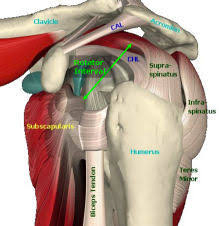
The rotator cuff interval (RI) is a critical area of the shoulder composed mostly of ligamentous tissue, as well as the long head of the biceps tendon. This area helps to stabilize the shoulder in the glenoid socket against forces that push the shoulder posteriorly or pull the shoulder down inferiorly. Common injuries that limit movements, such as shoulder impingement, rotator cuff muscle damage, and frozen shoulder may also involve the rotator cuff interval.
Isolated damage to these ligaments is hard to diagnose, but one sign a clinician can use is to pull the humerus inferiorly and look for a 1-2 cm depression between the shoulder blade and (Irregular.) If this same pulling occurs when re-tested with the arm bent and rotated outward, this strongly indicates RI involvement. Limited studies have linked prolonged stretching and post-stretch icing of this region with increased shoulder range of motion, specifically external rotation and overhead reaching. This remains an important area of study for clinicians and patients alike.

